HIV infection is one of the most dangerous in the modern world. The main danger of HIV is that the presence of the virus in the body practically does not manifest itself. The only way to determine is an HIV test.
Signs of HIV in men
In the early stages, the HIV virus, penetrating into the human body, is introduced into the immune system. At an early stage of infection, either there are no symptoms, or signs appear that accompany, for example, colds:
- There is a slight weakness, dizziness.
- The temperature rises slightly, from 37.5 to 38.2.
- There are pains in the throat, especially when swallowing.
- Slightly enlarged lymph nodes in the submandibular region, sometimes, in rare cases, there is pain in the axillary and inguinal lymph nodes.
- Diarrhea-like symptoms may also occur.
That is why it is important to consult a doctor if general symptoms occur: if an HIV infection is suspected, a specialist will issue a referral for a blood test.
Signs of AIDS in men
When the HIV virus is integrated into the immune system, the process of massive death of immune cells begins. This happens within two to three weeks. During this period, the following symptoms may occur:
- Headache of varying degrees of intensity.
- The weight decreases sharply, the appetite disappears.
- Chronic fatigue, increased fatigue.
- A slightly reddish or colorless rash appears on the skin. The rash covers large areas of skin all over the body, lasts from a week to ten days.
- Lymph nodes are constantly enlarged, painless, and hard on palpation.
After the rash disappears, the disease develops asymptomatically, which misleads the carrier. In men, the asymptomatic period can last from several months to several years, so the infection is often detected at an advanced stage, when acquired immunodeficiency syndrome develops.
AIDS is the last stage of HIV infection.
- Constant fever, aches all over the body.
- Falling vision.
- Shortness of breath, cough, persistent bronchitis and pneumonia.
- Digestive disorders, nausea, vomiting, diarrhea.
- Loss of coordination, convulsions.
- Development of cancerous tumors in lymphoid tissues.
- Coma states.
At this stage of the disease, the body is extremely depleted, and the most insignificant infection of a viral or microbial nature can become fatal. That is why it is so important to identify the HIV virus in the body in time and take action as soon as possible.
Which doctor should I contact?
If HIV infection has been detected, you should immediately contact an infectious disease specialist. There is such a doctor in every polyclinic at the place of residence. In rural areas, to contact an infectious disease doctor, you should contact the district center.
If HIV is suspected, the specialist will act in the following sequence:
- Analysis of complaints.
- History taking: what diseases the patient had, for how long. This will help determine the approximate timing of infection.
- Clinical examination - determination of the condition of the skin, lymph nodes, pharynx, nasal cavity. The liver, spleen are palpated, the lungs are auscultated.
- Analyzes: analysis of blood, urine, feces - to determine concomitant diseases.
- Blood test for the presence of antibodies to HIV.
It is impossible to completely cure HIV infection, however, condition control and competent care can significantly improve the patient's quality of life. Also, under the supervision of a specialist, you can delay the onset of AIDS as much as possible. It should be remembered that AIDS is always fatal, while HIV-infected people can lead lives close to full. Therefore, it is important to regularly visit a doctor and strictly follow all his appointments.
In our time, HIV is experiencing a real boom. Previously, this disease was registered only in the United States, now it has spread throughout the world. More than 20% of the total population have HIV. In the countries of Eastern Europe and Russia, there is an intensive increase in infection with the human immunodeficiency virus. Big cities are mostly affected.
The spread of pathology is associated with the following factors:
- unprotected sex;
- Use of infected syringes;
- Other instruments of medical importance;
- intrauterine transmission;
- When breastfeeding;
- If you start taking antiretroviral therapy in time, you can stop the progression of HIV and reduce the risk of developing AIDS. But these drugs are expensive and out of reach for many patients.
What is called HIV?
HIV is an abbreviated medical term that stands for AIDS virus. This disease reduces human immunity and is the cause of the development of other infectious diseases. This is due to the fact that the immune system does not protect the body from pathogenic bacteria and microorganisms.
Over time, the body of a man becomes susceptible to even harmless infections. A person with such an infection is classified as HIV-infected. Only A man can develop AIDS in 10 years.
How long does it take for HIV symptoms to appear?
There are no visible symptoms immediately after HIV infection.
After a couple of weeks, men may develop flu-like symptoms:
- Chills appear;
- The temperature is rising;
- Diarrhea;
- Lymph nodes become edematous;
- There is a general weakness.
Five years later, the first symptoms of HIV begin to appear. The first signs and secondary manifestations develop after 5 or more years from the moment of infection.
This is a secretive period or latent. But this does not mean that everything is calm in the body. The immune system begins to fight and try on its own to destroy the foreign virus. This is how antibodies are produced. Lymphocytes also fight the virus. But all these actions are meaningless and the immune system cannot neutralize HIV.
Symptoms of the acute stage
After a few weeks, the level of HIV in the blood becomes quite high. This first stage resembles all the symptoms of the flu. Most people do not feel infected. Mostly symptoms appear after 14-20 days.
Symptoms appear as follows:
- Increased fatigue;
- Rash on the body;
- An increase in temperature;
- There is a headache;
- Enlarged lymph nodes;
- Sore throat and sore throat;
- Night sweating;
- Diarrhea;
- Chills.
The main signs of HIV infection in men
Many doctors claim that at this time, the symptoms of HIV in the stronger sex can be observed in two days. But this will depend on the individual characteristics of the organism, the state of the immune system and the infection itself.
If you have found signs of HIV in yourself, then this is not a reason for panic, many of the symptoms are characteristic of other infectious diseases. Only after the test, it is possible to judge the presence of the disease.
First signs:
- Five days after infection, a rash appears on the body;
- Under the armpits, in the groin, on the neck, the lymph glands increase. They become compacted, but painless;
- Decreased appetite;
- Weakness and fatigue;
- All the time you want to sleep and there is no desire to work;
- The body's immune system is completely destroyed.
Signs of the disease after a year:
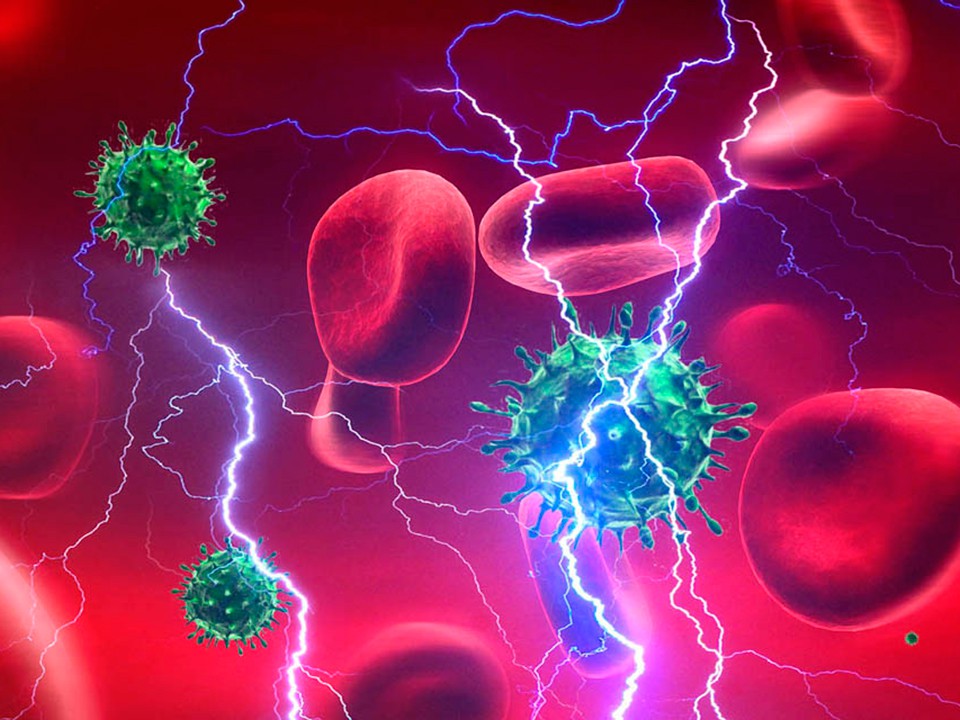
Signs of the disease after three years:
- Pneumocystis pneumonia:
- Temperature indicators increase;
- In the beginning there is a dry, then a wet cough;
- Shortness of breath during movement, then at rest;
- The general condition becomes worse;
- There is no proper effect in the treatment of antibiotic therapy.
- Kaposi's sarcoma:
- A tumor develops from the lymphatic vessels. Mostly observed in men at a young age;
- Externally, Kaposi's sarcoma is manifested by the formation of small tumors on the head, body, and mouth. cherry blossom tumor;
- There is a generalized infection;
- Memory decreases, and signs of pathology of the nervous system appear;
- Over time, dementia develops.
How to determine HIV at home?
There are two types of tests to determine HIV in the blood:
- Identification of proteins;
- Determination of antibodies against the virus.
There are also three types of results:
- When markers are found, the result is positive;
- Negative;
- Doubtful.
Recently, in more developed countries, there have been express tests, which you can make yourself at home. Their duration is up to 15 minutes.
Carrying out algorithm:
- Using a special spatula, which is attached with the test, you need to carefully take a scraping from the mucous membrane of the oral cavity;
- Next, put it in a container with a substance that will help determine the result.
Unfortunately, there are no such tests in our country yet, and it is possible to check for HIV only in a polyclinic. The analysis is given under a special code and helps to hide all information about the patient.
Diagnostics
Methods for diagnosing HIV:
- The most common method for diagnosing HIV is enzyme immunoassay.. Three months after infection, antibodies to HIV are produced in the patient's blood, which this research method detects;
- Immunoblot. This technique allows to detect antibodies to HIV. As a result, you can get a negative, positive and doubtful result of the examination;
- polymerase chain reaction. It allows you to identify the DNA and RNA of the virus. It will also allow you to find out what type of virus, the stage of the disease and the approximate period of infection;
- Express test. It is done in an emergency situation when an urgent surgical intervention is needed. It does not require much time and complexity and gives a high result during the examination. But in the future, this technique requires confirmation by deeper tests.
Prevention
Prevention methods are aimed at reducing HIV infection among the population.
Prevention methods:
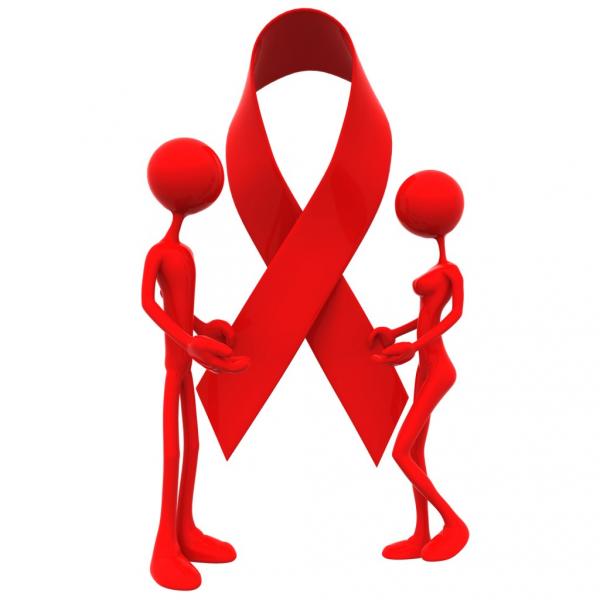
Statistics
Over the past year, more than 15,860 new HIV infections were registered. Nearly 3,000 cases occur in children under 15 years of age. Since the beginning of 1987, 287,000 cases of HIV have been identified. 38,453 people died from AIDS. Most of the infection comes from unprotected sex. Starting in 2014, due to the reduction in the fight against AIDS, the infection began to gain momentum.
HIV prevention during medical procedures
Due to modern sterilization techniques, as well as the use of disposable instruments, there is a significant risk of reducing infection. All donated blood is carefully screened before transfusion. At this time possibility contracting HIV after a transfusion is reduced to zero.
Creating a vaccine
HIV infection changes the genetic predisposition. Therefore, the creation of a vaccine at the present time cannot be created, solved, which scientists have not yet succeeded in.
Antiretroviral drugs
Basic principles for taking antiretroviral drugs:
- Treatment must be started on time, while there is still no persistent decrease in immunity and it must be carried out for life;
- Treatment includes up to 4 types of drugs;
- The treatment process is periodically monitored by taking an HIV test.
Outcome
HIV infection is a viral pathology of the immune system that progresses slowly. It leads to the formation of tumors, infections, and a decrease in the function of the immune system. To avoid contracting the virus, you need to have safe sex, a regular partner, and follow all the rules of personal hygiene.
Also important, start antiretroviral therapy as soon as possible, which will stop the progression of the disease and prevent it from going into the AIDS stage. A few days after infection, the patient will experience symptoms that are characteristic of the flu.
A patient with HIV infection is registered at a dispensary in a drug treatment or therapy center. Reception is provided for him medicines according to the AIDS program for free. Also, according to the law, disposable medical instruments are given to the patient.
Periodically, the patient is tested. The virus destroys human immunity, which is complicated by the development of other infectious diseases. Mostly The disease is transmitted from person to person through sexual contact.
In an infected person, most of the virus is in the semen, breast milk and vaginal discharge. Also, infection can occur through contact with the above liquids with a wound on the skin, on the mucous membrane of the mouth and vagina.
Previously, homosexuals were at risk. But now prostitutes, drug addicts, patients after transfusiology have joined this group.
Promiscuous sex life can lead to the fact that a man will acquire the immunodeficiency virus. Unfortunately, it is almost impossible to determine this lesion in the early stages, since there are no visible symptoms. The main difficulty of the virus lies in the fact that during the first three months after infection, even a comprehensive analysis is not able to confirm its presence in the body of a man. Therefore, the question arises, how can you determine the infection yourself in order to consult a doctor in a timely manner?
If you are attentive to your health, then already a few weeks after infection, you can notice a clear malaise. But, the majority of those infected do not attach any importance to this symptom, referring to a cold. After one or two months, a slightly elevated body temperature is added to the constant weakness, not exceeding 38 C. After two months, the virus completely passes into the asymptomatic stage. That is why most carriers, assuming that they suffered from mild cold symptoms for a month, detect the virus after a long time. Asymptomatic stage depending on individual characteristics body can drag on for a couple of years.
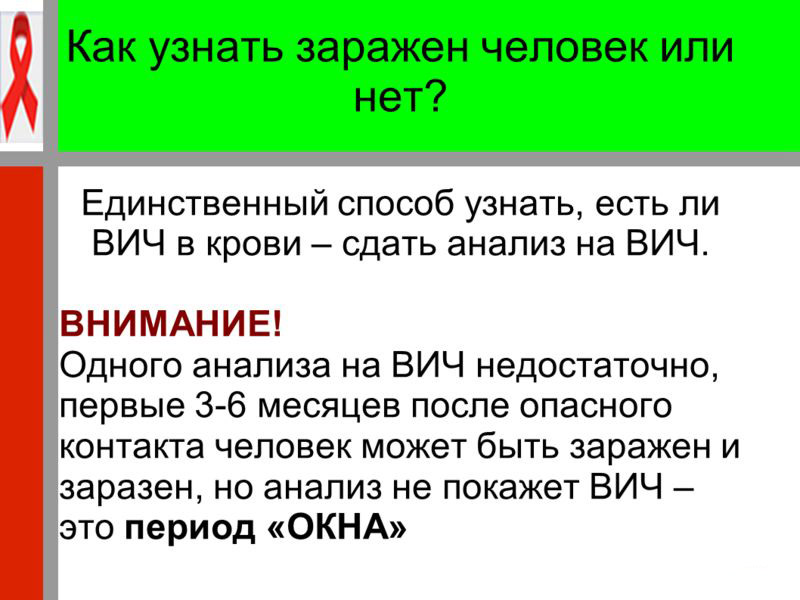
Despite the absence of any signs, the virus is still actively developing in the body. This leads to sad statistics, which show that on average, after a year, half of those infected die, after two years the mortality rate already rises to 80%, and three years after infection, one hundred percent death is noted.
Four main stages in the development of the course of the disease
| Stages | a brief description of |
|---|---|
| I-th latent form or incubation period | According to medical data, the duration of this period is one to three months, but in some cases it can be delayed for one year. It is characterized by the active spread of the immunodeficiency virus throughout the body, while the immune system is not yet damaged. This is followed by the next stage, which is determined by the production of HIV antibodies. |
| 2nd first noticeable symptomatology | After the development of so-called HIV antibodies, a noticeable reaction of the male body to the presence of the virus occurs. |
| III-th following ailments | At this stage, the virus makes itself felt, manifesting itself in characteristic symptoms. The danger lies in the fact that the processes occur irrevocably |
| IV final stage | HIV infection passes into the final stage of AIDS, which in all cases ends in death |
Characteristic symptoms
Signs of HIV infection in infected men do not differ at all from the course of the disease in female carriers of the virus. The main worrying question is how long does it take between the transition of HIV infection to AIDS? So, this period can drag on for several years, in best case it's fourteen years old. According to statistics, averages determine ten years of the life of a carrier of the virus. A month and a half later, the man has the following symptoms:
- uncharacteristic jumps in body temperature;
- constant feeling of chills;
- the likely occurrence of muscle pain;
- on palpation, a noticeable increase in the size of the lymph nodes is felt.
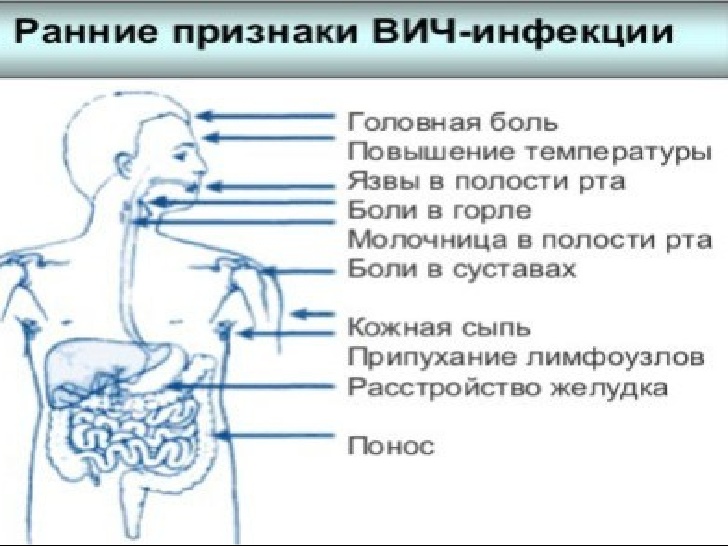
Anxiety symptoms begin to appear in the form of red rashes all over the body of a man. Often, colorless spots may appear on the skin. Such a rash can appear on the body even one week after infection.
The nature of the rash
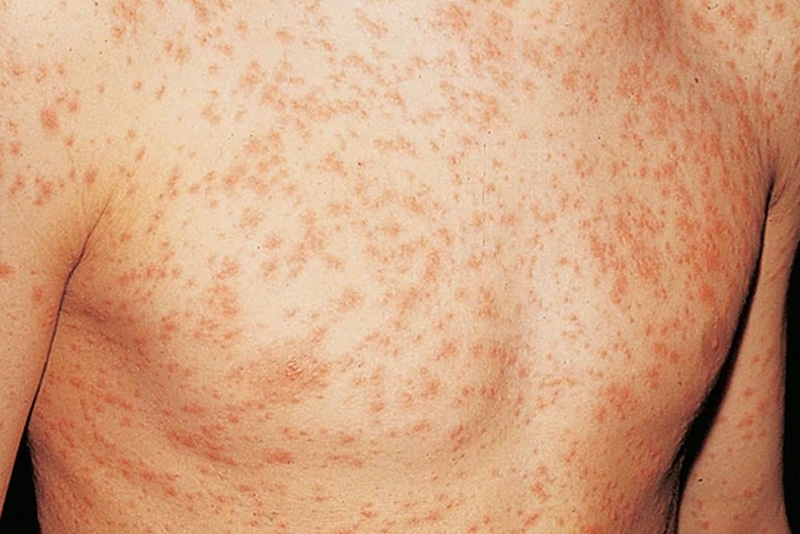
In addition to these symptoms, a man has an irresistible desire for sleep, physical activity is sharply reduced. There are pronounced headaches. A little later, a man may begin a depressive state. In parallel, the appearance of diarrhea is attributed to the primary symptoms, and an enlarged liver is palpated on palpation.
Attention! If the above symptoms are detected, a man needs to urgently contact a specialist, pass special tests to confirm the presence of the virus and begin immediate antiviral treatment.
You can learn about how the symptoms of HIV infection manifest themselves by reviewing the video.
Video - HIV Symptoms
Manifestations of symptoms after a month of infection
The general symptomatology is supplemented by pain in the joints, in particular, the performance of the musculoskeletal system is impaired. The resulting pain is exclusively aching in nature on an ongoing basis. Soreness in the knee and elbow bends is similar to the sensations after enhanced sports training. Despite this, the tone is noticeably reduced, which leads to muscle weakening.
Enlarged lymph nodes are the first sign that a pathological change is taking place in a man's body. A few months later, they are noticeable not only on palpation, but even on visual inspection. Swelling in their places occurs in the armpits, behind the ears, in the area of the elbows and collarbone. More in the later stages of the development of the virus, the lymph nodes increase in the inguinal zone (the increase occurs imperceptibly to the eye, but the pathological change is perfectly palpable on palpation). Even with a strong impact on the enlarged lymph nodes, the man will not feel any discomfort. Therefore, if no other visible and tangible changes are observed, then it is the lymph nodes that can warn of danger. This is confirmed by the absence of positive results in the treatment of lymph nodes for one month.
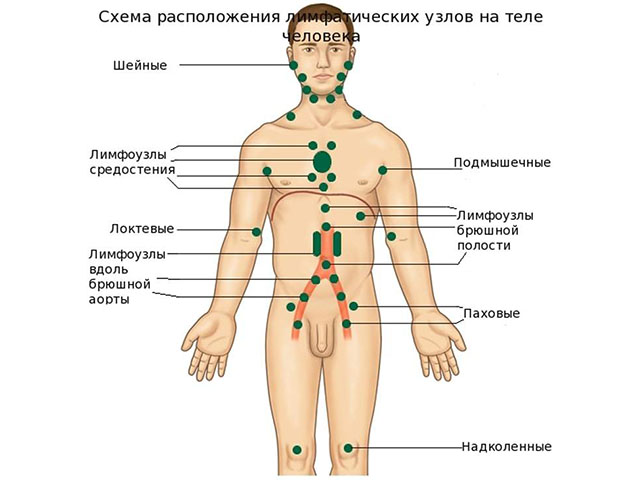
The subsequent detrimental effect of the infection occurs on other organs. After the defeat of the lymph nodes, the size of the spleen and liver changes, which is accompanied by pain in the left and right side. In addition, eating becomes more difficult due to the inflammatory process of the esophagus.
Carefully! Enlarged lymph nodes are not normal and require urgent examination. Exactly thyroid first reacts to the presence of infection.
Symptoms with a latent form of the disease
The latent period is determined from one month to several years, which is determined by the protective functions of the immune system. The danger of this period lies in the fact that the patient does not observe any special alarming symptoms, but at the same time his organs experience a destructive lesion. The maximum latency period is set at ten years, during which systems and organs receive a slow, detrimental effect from the virus. Thus, the disease passes into the manifest stage. The latent form of the virus cannot be detected without special studies.
Attention! Every person should undergo a full body examination at least once in their life to make sure that there are no deadly viruses.
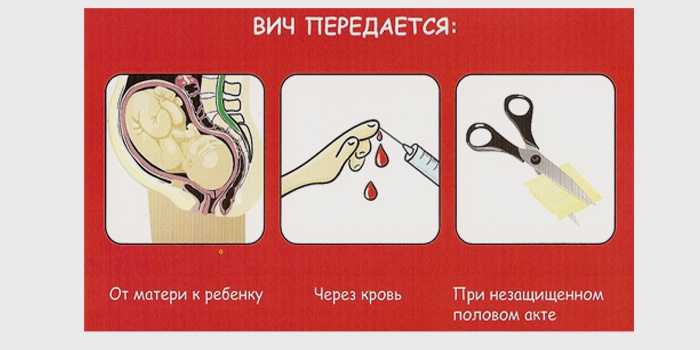
Signs of the third stage
This period of the course of the disease is characterized by significant destruction internal organs. HIV infection brings maximum harm to the immune system, which at the third stage of the disease is not able to affect the pathological cells of the virus. The disease is aggravated by the occurrence of additional infections, as well as oncological processes. The duration of the third stage does not exceed two years. According to medical data, the relationship between HIV infection and such diseases has been established:
- Herpes.
- Seborrhea.
- Candidiasis in the mouth.
- Fungal lesions of the extremities.
- Herpes zoster on the body.
The above ailments occur uncharacteristically in a complicated form, which is extremely rare in a man who is not a carrier of the infection. For example, if we talk about candidiasis or thrush in the oral cavity, then its usual symptoms are complemented by severe bleeding of the gums.
With pharyngitis and sinusitis, the immune system is not able to counteract the lesion, so the duration of treatment increases several times and is accompanied by various complications. This stage is replaced by the thermal period of the disease, which passes from HIV infection to fatal AIDS.
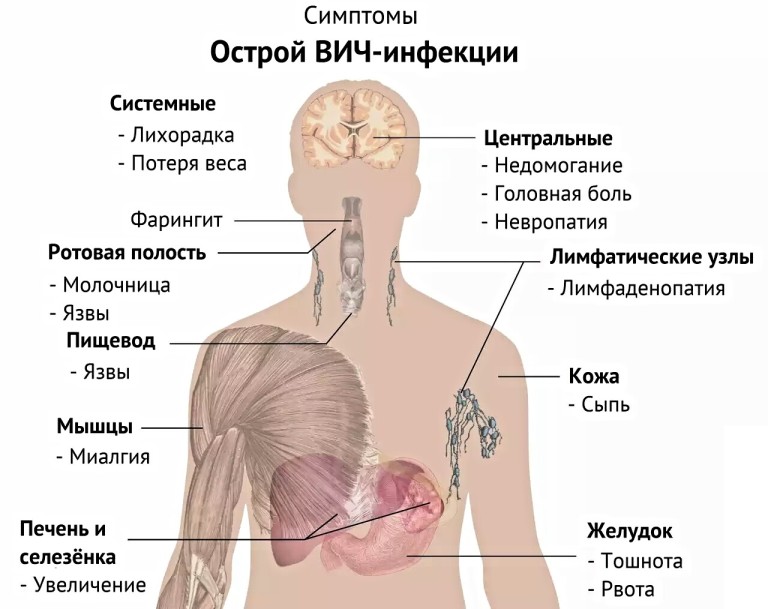
Last (thermal) stage: main symptoms
The man is in serious condition, which is characterized by the complete destruction of internal organs. The immune system is so overwhelmed by the virus that it cannot even deal with a cold infection, so a person can die from any disease. In this case, the therapy is exclusively of a stopping nature, eliminating local symptoms and slightly facilitating the patient's well-being.
Attention! If the patient refuses to take antiretroviral therapy, then life expectancy is reduced to three years.
This stage is characterized by the presence of concomitant diseases, which cause irreparable damage to health. These include:
- Sarcoma.
- Pneumonia.
- Tuberculosis.
- malignant formations.
- Cryptococcosis.
In addition to pathological destruction of internal organs, brain damage occurs, which is characterized by a significant deterioration in intelligence, poor memory, and difficulty in performing any mental load.
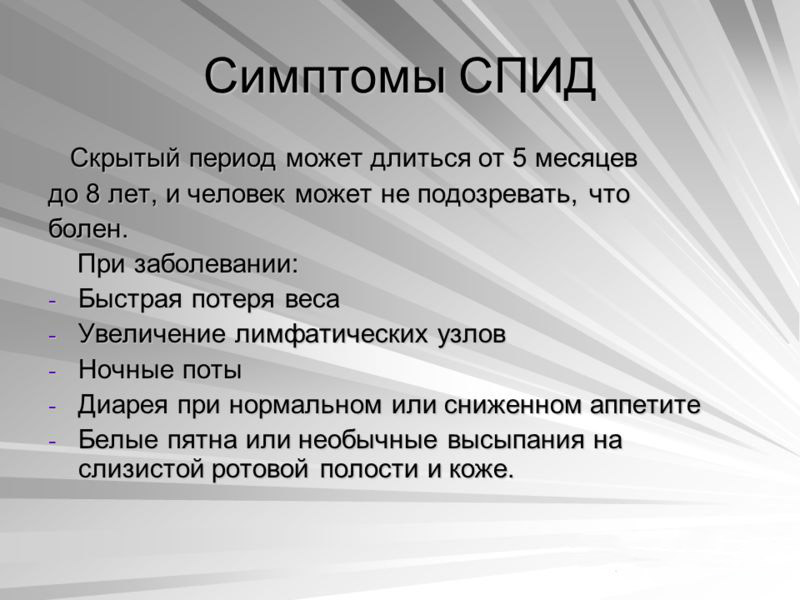
It is important! The presence of AIDS in the body is accompanied by a deterioration in vision, a fungal pathological lesion of the skin. The patient begins to rapidly lose weight.
Groups of infected
According to medical statistics, it is men who make up two-thirds of all carriers of the virus. This is explained by the fact that the basis of the representatives of the infected are bisexuals and homosexuals. It is the relationship with the same sex that increases the risk of acquiring HIV, which after a few years turns into a deadly AIDS disease.
The problem of untimely detection of the virus is that most men do not attach importance to the primary symptoms that prevent the onset of the disease, writing off all the symptoms that have arisen for SARS and other viral respiratory ailments.
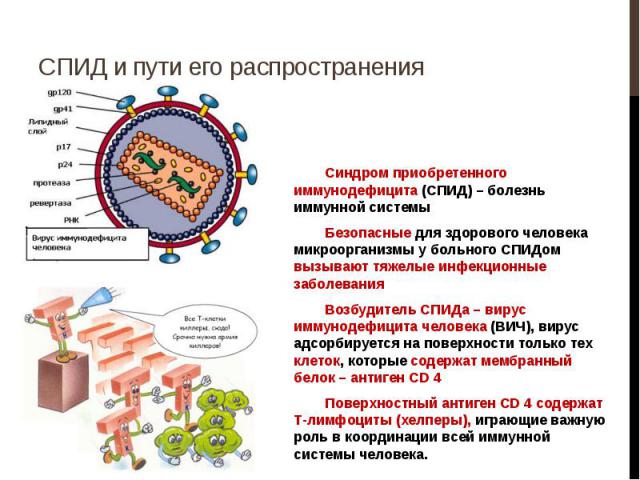
Unfortunately, fuzzy symptoms do not make it possible to independently determine the presence of the virus in the body. That is why it is very important for every man who is sexually active or addicted to drugs to take an HIV test once a year.
The human immunodeficiency virus is a very insidious and terrible disease that can rightfully be called the scourge of our time. The causative agent of the infection, once in the body, can hide for a long time (sometimes even for several years) without showing itself, but at the same time slowly and persistently undermines the functioning of the immune system. The long incubation period is the main reason for the sudden surge in the incidence of this disease and the rapid spread of the disease among various population groups.
Men and women with HIV sometimes do not even know about their illness themselves and unintentionally become carriers of the infection. The only and most reliable way to avoid infection is to be vigilant about your health, including in the intimate sphere. How to recognize the onset of the disease? Does the terrible diagnosis of HIV mean the complete end of life and is it worth panicking?
Clinic of the disease
There are four stages in the development of infection:
- First stage- incubation period. The latent form of the disease lasts from one to three months, however, in some cases this period can last up to a year or even more. Once in the body, the immunodeficiency virus is initially aimed at destroying the human defense system. But at the initial stage, until the body begins to produce HIV antibodies, immunity remains intact.
- During the transition of the disease to the second stage the first signs of infection are observed. The body begins to react to the virus and produces antibodies to fight it.
- Third stage characterized by the presence of obvious symptoms of HIV infection.
- fourth stage- AIDS.
In order not to miss the moment of infection and take the necessary measures in time, you should undergo special laboratory tests to detect HIV antibodies in the blood.
The first time the tests are taken two weeks after the alleged infection, the second time - after three to six months. Such periods are determined by the so-called serological window, that is, the period of time when the infection is not detected, even if the virus is already in the human body.
HIV: symptoms in men at various stages of the disease
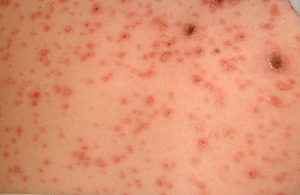 Symptoms of HIV infection in men are almost the same as in women. The disease is characterized by a long course: between the penetration of the virus into the human body and the last stage of HIV development (before the onset of AIDS) takes an average of 10-14 years. At an early stage, the symptoms of HIV in men may resemble signs of mononucleosis (a feverish condition in which there is a change in the composition of the blood), colds, and SARS. A man can notice the manifestations of HIV infection not earlier than in 1-1.5 months.
Symptoms of HIV infection in men are almost the same as in women. The disease is characterized by a long course: between the penetration of the virus into the human body and the last stage of HIV development (before the onset of AIDS) takes an average of 10-14 years. At an early stage, the symptoms of HIV in men may resemble signs of mononucleosis (a feverish condition in which there is a change in the composition of the blood), colds, and SARS. A man can notice the manifestations of HIV infection not earlier than in 1-1.5 months.
The first signs of AIDS in men may be the following:
- Symptoms of a common cold: a sudden increase in body temperature (up to 37.5 degrees), chills, muscle pain, nasal congestion, etc.
- Indefinite, vague mental disorders: overall decline tone, mood. The patient has irritability, he suffers from boredom and apathy.
- There may be a rash on the skin in the genital area or throughout the body.
However, after 30-50 days the symptoms of the disease completely disappear and a calm stage begins, which can last up to several months or more. But this does not mean at all that the disease has cured itself. The pathological process continues to develop during the asymptomatic stage. After its completion, the patient has new, more serious manifestations of HIV. If no measures are taken, then the terminal and already incurable stage - AIDS - will soon set in.
The duration of the asymptomatic stage depends on the characteristics of the course of the disease and the general condition of the body and can range from several months to five years.
Is it possible to detect HIV without obvious symptoms. No. Without a medical examination, this is not yet possible. You can determine the presence of an infection by conducting laboratory blood tests, and if you have even the slightest suspicion of HIV infection, you must urgently go to the clinic and be tested for the virus.
Second stage: signs of HIV infection in men
The timing of the end of the temporary lull stage is very vague and can range from one to three years. After the incubation period, further development is characterized by an increase in the lymph nodes of several groups. If you notice these signs, then you have begun another stage - generalized lymphadenopathy, which may soon turn into AIDS.
At this stage, in addition to swollen lymph nodes, patients have the following symptoms of HIV infection:
- The temperature rises to 38 degrees.
- Cough with expectoration.
- Neoplasms on the body of a red-violet hue. Most often, this symptom is very pronounced in men.
- Memory deterioration. The infection can cause dementia.
If the patient at this time abuses alcohol, takes drugs and / or is a heavy smoker, then the latent stage passes much faster and may end after two months.
Despite the fact that there are no obvious symptoms of the disease, the virus will declare itself, for example, non-healing scratch or wound. If you pay attention to any changes in your body: you often get sick with fungal or colds, or suffer from long-term non-healing cuts, etc., you need to consult a specialist to identify HIV infection.
It is necessary to know that HIV is transmitted through unprotected sexual intercourse (including oral, anal and vaginal) and through blood (sharing one syringe during drug injections, blood transfusion).
Symptoms of the acute form of the disease
 In the third stage, the symptoms of immunodeficiency appear quite clearly, you just need to monitor the state of your body and write down everything that happens to it.
In the third stage, the symptoms of immunodeficiency appear quite clearly, you just need to monitor the state of your body and write down everything that happens to it.
The main signs of HIV infection in advanced form similar to infectious mononucleosis and may be as follows:
- Also, as in the initial stage, symptoms of a cold appear (nasal congestion, pain and sore throat, etc.).
- Body temperature rises (up to 38 degrees) for no apparent reason. Reception of febrifugal means of result does not give.
- Appears apathy, lethargy, general weakness of the body. The patient eschews friends, colleagues and even his beloved woman, he is no longer interested in work and hobbies.
- Lymph nodes are enlarged in the groin area and on the neck. At the same time, pain is completely absent even if you press the seals.
- For no apparent reason, increased sweating begins, especially at night.
- Red rashes are clearly visible on the body, which periodically disappear.
At the third stage of the development of HIV infection, a strong destruction of internal organs and almost complete lack of immunity. The body's defense system has already weakened so much that it simply cannot cope with viral cells. This stage is characterized by the addition of comorbidities caused by oncological processes, various harmful microflora, as well as various infections.
The maximum duration of the acute stage is two years. During this period, most often in men with HIV, diagnose the following diseases:
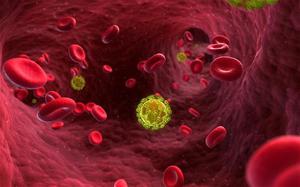
The course of the above pathologies takes place in an acute form with the possible appearance of rather unpleasant symptoms uncharacteristic of HIV. For example, disturbances in the work of the blood supply system are supplemented by extensive hematomas, and oral candidiasis is accompanied by increased bleeding of the gums.
Diseases such as sinusitis, otitis or pharyngitis can be aggravated by severe complications, and the treatment of these pathologies is delayed for a long time.
At the end of the acute stage of HIV, the disease takes the last terminal form, and the diagnosis at the same time sounds like acquired immunodeficiency syndrome (AIDS).
AIDS - terminal stage of HIV
In fact, this is the last stage of the disease, which is 100% fatal. The life expectancy of the patient is no more than three years, depending on the presence or absence of antiretroviral therapy.
The condition of a patient with AIDS is characterized by the complete destruction of all internal organs, the failure of the immune system, as a result of which a man cannot completely get rid of concomitant pathologies, while infectious processes develop at a cosmic speed, without encountering resistance from the body. In this case, the therapy of concomitant diseases is aimed only at relieving the symptoms, and not at curing the pathology.
Manifestations of AIDS in the terminal stage of HIV development
Severe ailments that greatly affect the health of the patient join the already existing viral infections and pathologies. These can be the following diseases:
- Cryptococcosis;
- sarcoma;
- malignant lymphomas;
- pulmonary tuberculosis;
- pneumonia;
- cryptosporidiosis;
- toxoplasmosis;
- fungal lesions of a generalized nature.
In addition to the presence of pathologies of internal organs, AIDS is characterized by changes in the brain of a man: the patient has memory impairment, a decrease in the level of intelligence, while any mental stress, even minor ones, is given with great difficulty.
Acquired immunodeficiency syndrome is conditionally divided into four forms, each of which has a certain set of manifestations.
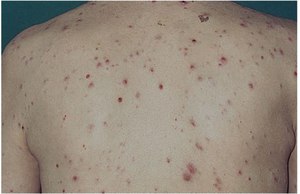
 Any form of AIDS is characterized severe weight loss up to complete exhaustion. To diagnose the disease at the terminal stage, no clinical examinations are even required.
Any form of AIDS is characterized severe weight loss up to complete exhaustion. To diagnose the disease at the terminal stage, no clinical examinations are even required.
The human immunodeficiency virus is a rather serious and dangerous pathology that affects the human immune system. It is impossible to completely get rid of this disease, however, it is possible to contain the development of HIV infection in the early stages using modern drugs for this.
HIV is not a sentence. With a timely visit to the clinic and compliance with all medical recommendations, it is quite possible to lead a habitual lifestyle without denying yourself anything.
HIV symptoms in men
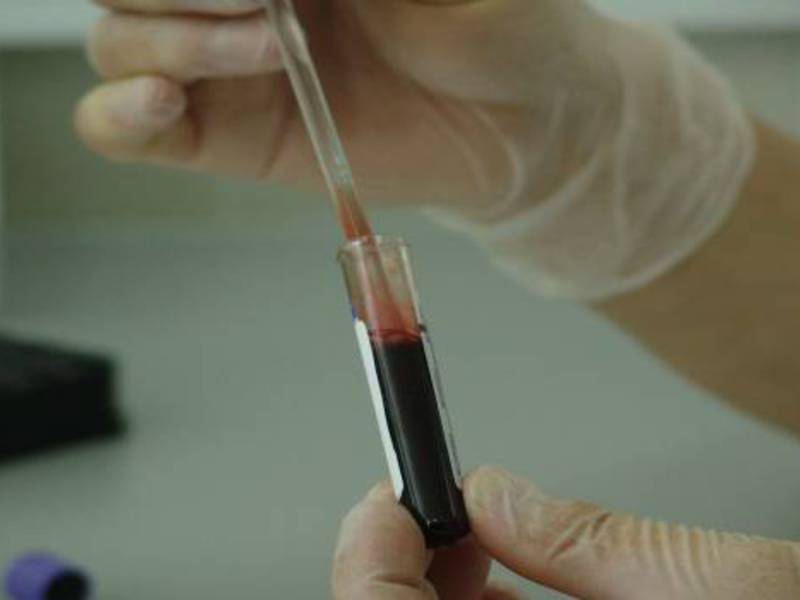
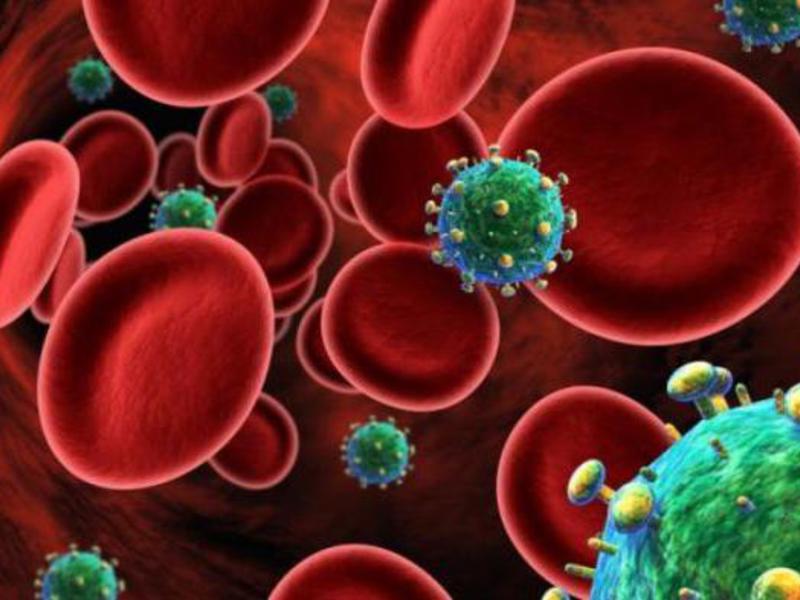
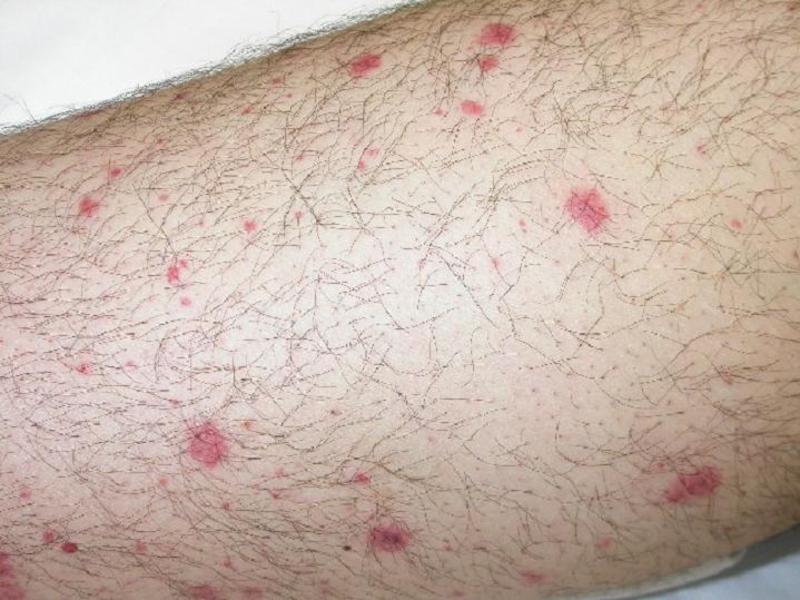

For several decades in a row, one of the most dangerous viruses is immunodeficiency. The danger of infection lies in the fact that after entering the body for several years, a person may not even suspect that he is a carrier of the virus. At the same time, the virus confidently in a latent form undermines the protective functionality of the immune system, making the body very vulnerable to all third-party infections. According to statistics, the majority of patients, after confirming the diagnosis of HIV, in desperation refuse to fight and use maintenance therapy, thereby bringing the terminal stage closer. The only way to prevent infection is to take care of your health and have a safe sex life. Timely detection of the virus at an early stage and the use of special therapy helps to increase life expectancy without losing its quality. Therefore, it is very important to pay attention to any symptoms that arise.
HIV is a very complex virus that, once it enters the body, long time does not make itself felt, thereby aggravating the clinical picture. If after intercourse or other manipulation that is directly related to blood (a needle prick on the street, blood donation, surgery, etc.), a man has suspicions, then it is best to do an express analysis.
Attention! You should not rely on the results of the first HIV test, since the virus is in a latent form for a long time and may not even be confirmed by a laboratory test. In this case, it is recommended to undergo a second express test after a certain period of time and make sure that there is no virus.
The analysis carried out can confirm the diagnosis only six months after infection, so two tests are necessary with an interval of six months. Despite the inability to determine the presence of a virus in the body, the first minor symptoms of the disease may appear in the latent period. Moreover, medical studies have shown that the symptoms of the virus in men are more pronounced than in women. Complications of timely diagnosis to the extent of symptoms may lie in the similarity of viral signs with symptoms of colds, flu and other acute respiratory infections.

It is important! The HIV virus can even manifest itself as a banal overwork, therefore, with atypical manifestations, it is best to go for tests.
When cold symptoms occur, a larger percentage of men try to alleviate the symptoms on their own and not visit a specialist. However, doctors, collecting a patient's history, may be mistaken in making a diagnosis. Thus, the prescribed treatment can only temporarily alleviate the condition, but not eliminate the root cause. Consequently, the virus will make itself felt, but in the form of new signs.
The end of the latent period may be characterized by a complex of typical HIV symptoms. In the first months, the man has manifestations of infectious diseases. Therefore, if a man leads a promiscuous sex life, and at the same time often and for a long time suffers from colds, then the possibility of HIV infection cannot be ruled out. The following symptoms should not be ignored:
- body temperature is kept within 37 degrees;
- observed at night elevated level sweating;
- persistent mild cough caused by a sore throat;
- indigestion;
- uncharacteristic weight loss;
- excessive fatigue even after minor exertion.
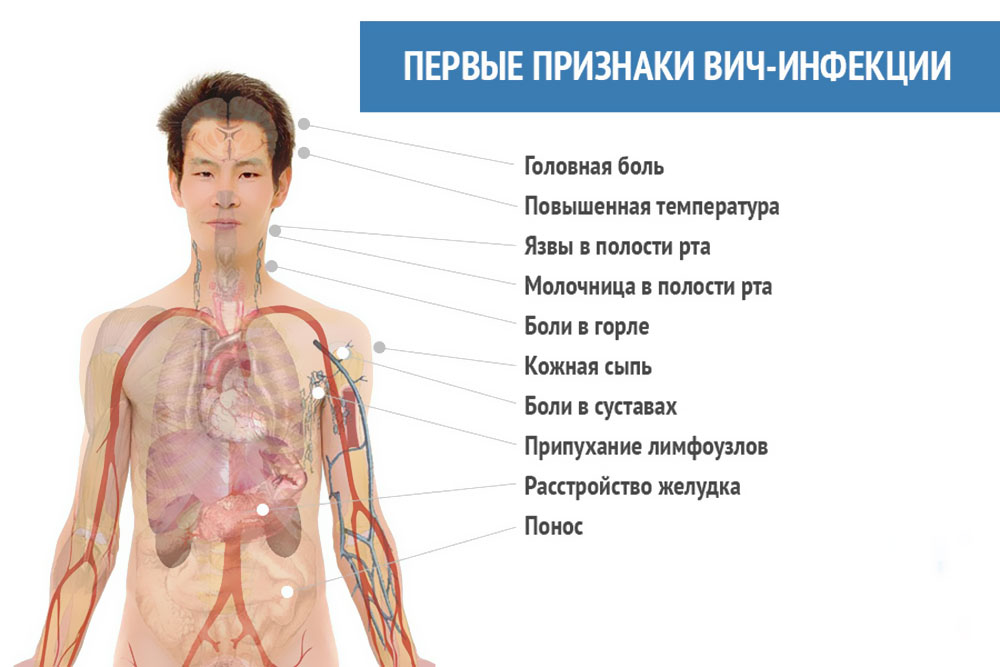
This is dangerous! HIV is difficult to diagnose, so in most cases cold symptoms are treated.
Main symptoms at an early stage
The carrier of the virus notes a slight increase in temperature, which is accompanied by a feverish state. It is characteristic that the patient feels unwell throughout the latent period.
This condition is explained by a typical reaction of the body: the immune system begins to actively produce white blood cells, which in turn try to eliminate the pathogenic virus. As a result, the man has a temperature of about 37-38 degrees, which does not disappear for a month. If such a symptom is present, then you should immediately go to the doctor. Additional symptoms may be uncharacteristic before this dizziness, lack of appetite, nausea.
The main symptom that misleads both the specialist and the wearer himself is a clear cough with signs of a sore throat. This symptom occurs through an inflammatory process that is activated in the lymphoid tissue of the tonsils. It is this symptom that prompts the treatment of a cold infection or flu. A specialist notices a diagnosis error when, after fourteen days, the patient's condition does not improve (it is standard that a cold lasts no more than 7-10 days).

Prolonged diarrhea is the second clear sign of HIV infection in the body. If the intestinal disorder lasts more than a month, then it is necessary to go for an examination, because dysbacteriosis and other gastrointestinal disorders cannot be observed for so long. Diarrhea is accompanied by a lack of appetite, resulting in increased weight loss.
Symptoms after a few years
While the virus is in a latent form, there are no obvious manifestations of it, but after a few months, a year, a couple of years, a man feels uncomfortable changes.
| Symptoms that appear at an early stage (immediately after the latent period) | Symptoms after a year | Symptoms after three years |
|---|---|---|
| Alarming signs of immunodeficiency may be absent or manifest as an acute cold infection. The most common symptoms of the first stage include: Mental disorders, which manifest themselves as constant irritability, a state of apathy, depression; | This period of time is the incubation period. After the manifestation of the first signs of HIV, which are similar to cold symptoms, there comes a period of absence of any viral manifestations. At this stage, it is impossible to independently diagnose the virus, only a specialized examination is required. | It is very difficult to determine how long the incubation period will end - it can happen in a year, two or three. At this stage, enlarged lymph nodes are felt in a man, especially in the inguinal region. Thus begins generalized lymphadenopathy. Additionally, after an increase in lymph nodes, the following symptoms are observed: Neoplasms appear on the skin throughout the body in the form of red-violet swelling (clearly manifested in men); |
How the symptoms of HIV appear after infection and what signs are typical for men can be found in the video.
Video - HIV symptoms in men
Acute viral disease
Infectious mononucleosis - it is with this disease that the symptoms of the acute stage in HIV are compared. Among the pronounced signs are the following:
- For a long time (up to one month), the temperature remains within 38 degrees, while after taking the antipyretic, there is no decrease.
- Lymph nodes are noticeably enlarged in the groin and neck area. It is distinctive that the large size of the lymph nodes is not characterized by soreness even when pressed on them.
- Cold symptoms persist (namely cough, sore throat, stuffy nose).
- Under the influence of the virus, the carrier undergoes mental changes, he begins to lose interest in life, apathy and irritability set in.
- The general condition is characterized chronic fatigue and lethargy.
- At night, increased sweating occurs, which is not the norm in a healthy person.
- A clear red rash appears on the skin, but this symptom does not always appear and is not temporary.
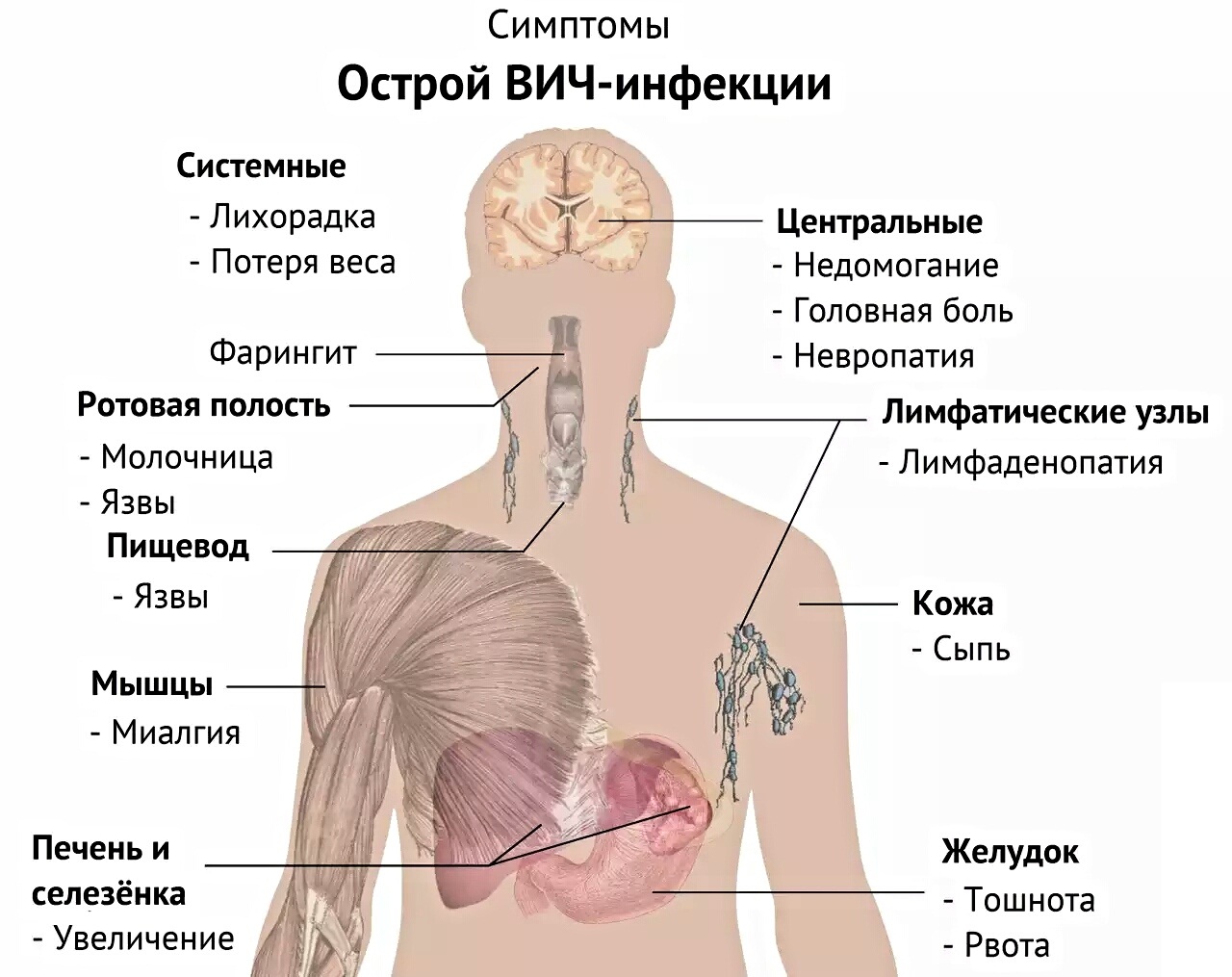
Attention! You can not ignore the above symptoms and continue to have an active sex life without barrier contraceptives. All this time, the carrier infects new people without even knowing it. Therefore, in order to protect others and continue to lead an active lifestyle, it is necessary to undergo a rapid test to detect HIV infection every six months.
How long does it take for HIV to show up?
Quite a few years can pass from the moment the virus enters the body until the decline is activated, this case everything will depend on the individual characteristics of each organism. Scientists noted that in some the disease makes itself felt after a year, while in others the latent form can drag on for a dozen. The average period of time through which HIV passes into the stage of AIDS is determined at 10-12 years.
If we talk about how long it takes to find out about HIV infection, then basically, after the virus enters the body, one month passes and the patient begins to be disturbed by cold symptoms. The primary stage is characterized by chills, enlarged lymph nodes, soreness in the muscles, and a slight increase in temperature. The listed symptoms should be remembered and, if they are detected, urgently go for testing.


